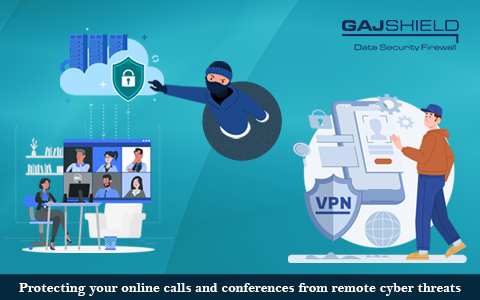Protecting your online calls and conferences from remote cyber threats
Ever since the spread of the COVID-19 pandemic, the use of online conferencing has become a vital part of businesses. It provides an easy connection with clients and colleagues, no matter the location. Working from home or other remote locations is convenient as it helps to save the time and cost of travel. However, with the increase in the use of online platforms by organisations or individuals also comes the threats of cyber-attacks.

Protection of Online Calls and Meetings
In the current scenario, video conferencing and other collaboration software have become indispensable. With its growing popularity and becoming the preferred choice for hosting or conducting meetings, it is imperative to protect its security from remote cyber threats.
1. Controlling Access
The video conferencing platform hosts can control access by setting a password, holding attendees in a virtual wait room, and approving them individually.
2. Not Reusing Meeting IDs
Reusing a set meeting ID can be convenient, but if the same link reaches the wrong person, they can join in and access the information being shared.
3. Using Antivirus and Internet Security at Remote Locations
Investing in comprehensive antivirus software is an effective measure for the organisation and its employees. It eases the stress of conducting a meeting remotely and makes it secure.
4. Using VPN
A Virtual Private Network (VPN) can help maximise privacy and security. A VPN hides the user’s IP address, making it harder for the hacker to get into their system. It protects not only the user’s online meeting but also other sensitive information like bank account details and personal emails, creating a shield against cyber threats.
5. Locking a Meet once Limit is Met
Similar to locking a room physically for privacy, after an online meeting has reached the limit of attendees, the host of the meeting should lock the room as it will prevent any unauthorised entry.
6. Using Encryption
When selecting any software for video conferencing, organisations or individuals should make sure that it provides end-to-end encryption.
7. Keeping software updated
A timely update of any collaborative or virtual meeting software will help increase protection against threats. These software roll out malware and security fixes to keep the system and the user secure.
As more of the workings of an organisation is becoming digital, the risk of cyber threats and attacks is also increasing. Organisations should ensure and train their employees to conduct secure online meetings. Users of online conferencing software should be careful while sharing confidential information through this software.
Gajshield’s data security tools can help you safeguard your hybrid working ecosystems from cyber-attacks. Kindly contact us to know more about our services.
Get In Touch With Us
Subscribe to our Newsletter
2025 © GajShield Infotech (I) Pvt. Ltd. All rights reserved.
